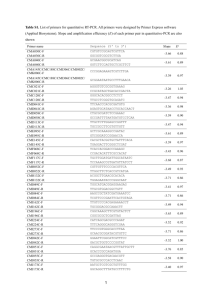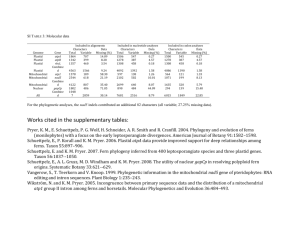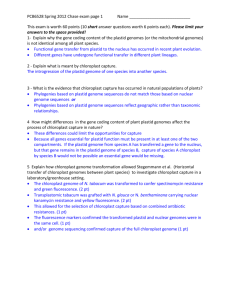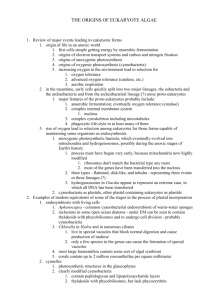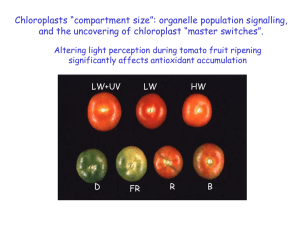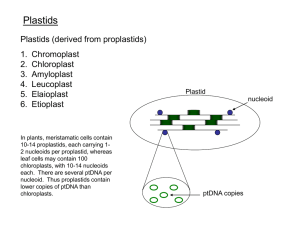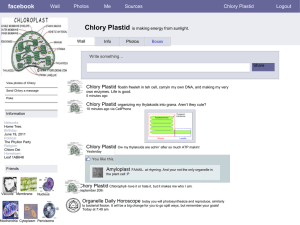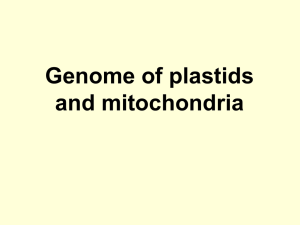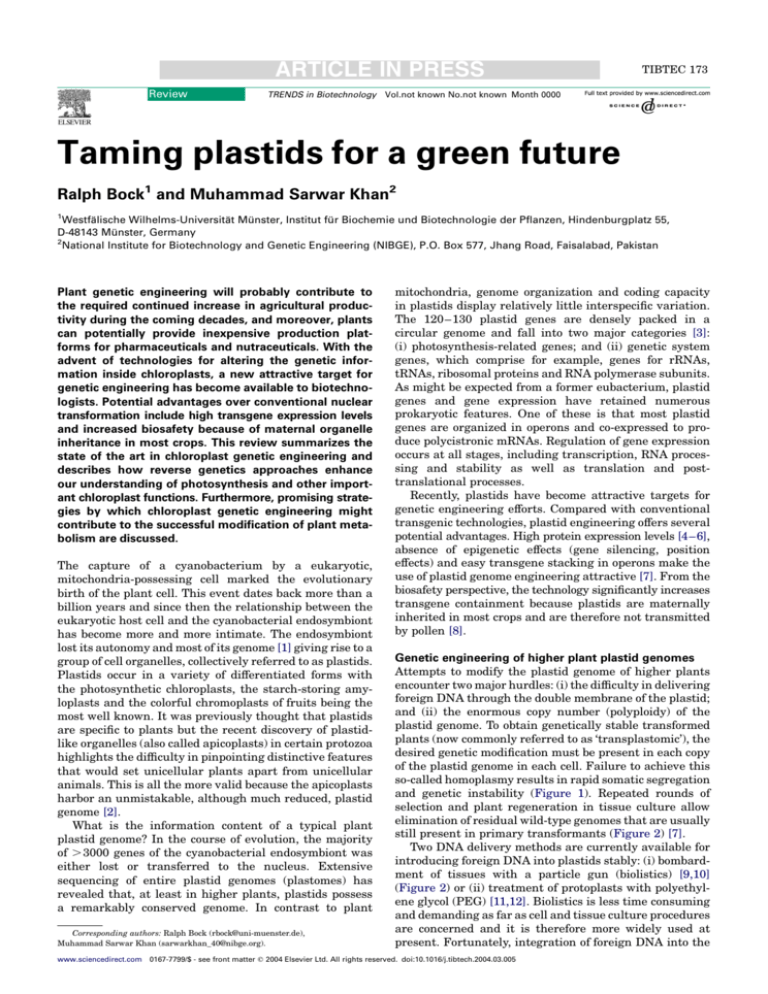
ARTICLE IN PRESS
Review
TRENDS in Biotechnology
TIBTEC 173
Vol.not known No.not known Month 0000
Taming plastids for a green future
Ralph Bock1 and Muhammad Sarwar Khan2
1
Westfälische Wilhelms-Universität Münster, Institut für Biochemie und Biotechnologie der Pflanzen, Hindenburgplatz 55,
D-48143 Münster, Germany
2
National Institute for Biotechnology and Genetic Engineering (NIBGE), P.O. Box 577, Jhang Road, Faisalabad, Pakistan
Plant genetic engineering will probably contribute to
the required continued increase in agricultural productivity during the coming decades, and moreover, plants
can potentially provide inexpensive production platforms for pharmaceuticals and nutraceuticals. With the
advent of technologies for altering the genetic information inside chloroplasts, a new attractive target for
genetic engineering has become available to biotechnologists. Potential advantages over conventional nuclear
transformation include high transgene expression levels
and increased biosafety because of maternal organelle
inheritance in most crops. This review summarizes the
state of the art in chloroplast genetic engineering and
describes how reverse genetics approaches enhance
our understanding of photosynthesis and other important chloroplast functions. Furthermore, promising strategies by which chloroplast genetic engineering might
contribute to the successful modification of plant metabolism are discussed.
The capture of a cyanobacterium by a eukaryotic,
mitochondria-possessing cell marked the evolutionary
birth of the plant cell. This event dates back more than a
billion years and since then the relationship between the
eukaryotic host cell and the cyanobacterial endosymbiont
has become more and more intimate. The endosymbiont
lost its autonomy and most of its genome [1] giving rise to a
group of cell organelles, collectively referred to as plastids.
Plastids occur in a variety of differentiated forms with
the photosynthetic chloroplasts, the starch-storing amyloplasts and the colorful chromoplasts of fruits being the
most well known. It was previously thought that plastids
are specific to plants but the recent discovery of plastidlike organelles (also called apicoplasts) in certain protozoa
highlights the difficulty in pinpointing distinctive features
that would set unicellular plants apart from unicellular
animals. This is all the more valid because the apicoplasts
harbor an unmistakable, although much reduced, plastid
genome [2].
What is the information content of a typical plant
plastid genome? In the course of evolution, the majority
of . 3000 genes of the cyanobacterial endosymbiont was
either lost or transferred to the nucleus. Extensive
sequencing of entire plastid genomes (plastomes) has
revealed that, at least in higher plants, plastids possess
a remarkably conserved genome. In contrast to plant
Corresponding authors: Ralph Bock (rbock@uni-muenster.de),
Muhammad Sarwar Khan (sarwarkhan_40@nibge.org).
mitochondria, genome organization and coding capacity
in plastids display relatively little interspecific variation.
The 120–130 plastid genes are densely packed in a
circular genome and fall into two major categories [3]:
(i) photosynthesis-related genes; and (ii) genetic system
genes, which comprise for example, genes for rRNAs,
tRNAs, ribosomal proteins and RNA polymerase subunits.
As might be expected from a former eubacterium, plastid
genes and gene expression have retained numerous
prokaryotic features. One of these is that most plastid
genes are organized in operons and co-expressed to produce polycistronic mRNAs. Regulation of gene expression
occurs at all stages, including transcription, RNA processing and stability as well as translation and posttranslational processes.
Recently, plastids have become attractive targets for
genetic engineering efforts. Compared with conventional
transgenic technologies, plastid engineering offers several
potential advantages. High protein expression levels [4–6],
absence of epigenetic effects (gene silencing, position
effects) and easy transgene stacking in operons make the
use of plastid genome engineering attractive [7]. From the
biosafety perspective, the technology significantly increases
transgene containment because plastids are maternally
inherited in most crops and are therefore not transmitted
by pollen [8].
Genetic engineering of higher plant plastid genomes
Attempts to modify the plastid genome of higher plants
encounter two major hurdles: (i) the difficulty in delivering
foreign DNA through the double membrane of the plastid;
and (ii) the enormous copy number (polyploidy) of the
plastid genome. To obtain genetically stable transformed
plants (now commonly referred to as ‘transplastomic’), the
desired genetic modification must be present in each copy
of the plastid genome in each cell. Failure to achieve this
so-called homoplasmy results in rapid somatic segregation
and genetic instability (Figure 1). Repeated rounds of
selection and plant regeneration in tissue culture allow
elimination of residual wild-type genomes that are usually
still present in primary transformants (Figure 2) [7].
Two DNA delivery methods are currently available for
introducing foreign DNA into plastids stably: (i) bombardment of tissues with a particle gun (biolistics) [9,10]
(Figure 2) or (ii) treatment of protoplasts with polyethylene glycol (PEG) [11,12]. Biolistics is less time consuming
and demanding as far as cell and tissue culture procedures
are concerned and it is therefore more widely used at
present. Fortunately, integration of foreign DNA into the
www.sciencedirect.com 0167-7799/$ - see front matter q 2004 Elsevier Ltd. All rights reserved. doi:10.1016/j.tibtech.2004.03.005
ARTICLE IN PRESS
Review
2
TRENDS in Biotechnology
1 cm
5 cm
Figure 1. Generation of homoplasmic transplastomic cell lines in tissue culture
(a) and whole plants (b). Homoplasmy was made visible by knocking out chloroplast-encoded photosynthesis genes [21] (S. Stegemann and R.B., unpublished).
Green sectors still contain wild-type genomes and are therefore photosynthetically
active. White sectors are homoplasmic for the transplastome and thus photosynthetically incompetent.
Plastid transformation vector
aadA
A
B
Gene delivery
Selection
A
Vol.not known No.not known Month 0000
plastid genome occurs via homologous recombination,
which appears to operate in plastids at high efficiency
(Figures 2, 3).
The successful generation of tobacco plants with stably
transformed plastid genomes (transplastomes) [9,10] was
followed by the first biotechnological application of this
technology: expression of a Bacillus thuringiensis (Bt)
toxin gene from the tobacco plastid genome yielded high
accumulation levels of the Bt toxin protein of 3 – 5% of the
total soluble protein (TSP) and produced plants that
displayed high-level resistance to herbivorous insects [13].
Subsequently, co-expression with two upstream small
reading frames further increased Bt protein accumulation,
even resulting in crystallization of the protein inside the
chloroplast [4]. Another spectacular application of the
technology was the production of the human growth
hormone, somatotropin, in transgenic tobacco plastids,
which gave rise to as much as 7% TSP and demonstrated
the remarkable capacity of the chloroplast to correctly
form disulfide bonds in a protein of eukaryotic origin [5].
Encouraged by these expression data, the adaptation of
plastid transformation protocols for major food crops
seemed to be the next logical step. However, extending
the crop range was significantly more difficult than initially anticipated [14]. After the first successful transformation in tobacco, it took almost ten years before plastid
transformation was achieved for two other Solanaceae
species; potato [15] and tomato [16]. An encouraging
Plastid transformation vector
B
A
ptDNA
Regeneration
Additional rounds of selection
and regeneration
A
aadA
TIBTEC 173
aadA
B
Plastid transformation vector
A
aadA
ycf*
B
ycfdel
B
ycf
A
B
ycf
A
ptDNA
B
ptDNA
Transformed ptDNA
Shoot proliferation and rooting
TRENDS in Biotechnology
Figure 2. Biolistic chloroplast transformation and transgene integration into the
plastid genome via homologous recombination. Left panel: The transformation
vector is shot into living leaf cells on the surface of microscopic gold (or tungsten)
particles. Small leaf pieces are subsequently exposed to a regeneration medium
containing the plastid translational inhibitor spectinomycin. Because the transformation vector contains a spectinomycin resistance gene (aadA), transplastomic
cells can regenerate despite the presence of spectinomycin. Primary transformants
are usually heteroplasmic and, by passing tissue samples through several
additional rounds of regeneration under antibiotic selection, residual wild-type
genomes are eliminated. Finally, homoplasmic shoots are rooted in phytohormone-free medium. Right panel: Targeting of a transgene to a non-coding intergenic region of the plastid genome (ptDNA). The aadA gene is tethered to a plastid
promoter and Shine– Dalgarno sequence (yellow) and a plastid 30 untranslated
region (UTR; red) conferring transcript stability. Transgene integration into the
plastid genome occurs by two homologous recombination events in the flanking
regions (dashed lines). Any transgene of interest can be co-incorporated by physically linking it to the aadA marker gene. The transgene of interest can either be
driven by its own (plastid-derived) expression signals or combined with the aadA
to form an operon. In the latter case, the transgene cassette consists of the
following modules: Promoter ! Shine– Dalgarno sequence 1 ! Coding region
1 ! Shine –Dalgarno sequence 2 ! Coding region 2 ! 30 UTR.
www.sciencedirect.com
A
aadA
B
A
aadA
ycf*
B
ycfdel
Transformed ptDNA
Transformed ptDNA
TRENDS in Biotechnology
Figure 3. Experimental strategies for reverse genetics in plastids. An open reading
frame of unknown function (ycf ) can be disrupted by insertion of the aadA cassette
encoding the spectinomycin resistance marker (left panel). Two homologous
recombination events in the flanking regions (dashed lines) mediate integration of
the ycf knockout allele (designated here as ycf del) into the chloroplast genome.
More-subtle changes (e.g. point mutations) can be introduced by placing the aadA
marker into an adjacent intergenic region (right panel), which however results in
only partial linkage of spectinomycin resistance with the desired change in the ycf
(designated ycf*). Consequently, not all chloroplast transformants will carry the
mutant ycf* allele because homologous recombination between the aadA and the
mutation in the ycf (dotted line) can genetically separate the two traits.
ARTICLE IN PRESS
Review
TRENDS in Biotechnology
feature of the tomato system is the high-level foreign
protein accumulation even in ripe red tomatoes, offering
great promise for the production of edible vaccines,
antibodies and other biopharmaceuticals in plants [16].
Some progress was recently made with plastid transformation in Brassicacea species [17– 19] and rice [6] although
remaining problems with heteroplasmy [6,19] and plant
fertility [17] are yet to be solved.
Reverse genetic analysis of plastid genes and open
reading frames
In addition to putting extra genes into plastids, the advent
of routine methods for plastid genome engineering has
opened up the exciting possibility of introducing almost
any desired change into endogenous plastid genes.
Although not of immediate practical value, such reverse
genetics studies have contributed significantly to our
understanding of photosynthesis, its molecular components and their molecular interactions. This knowledge
is, in turn, crucial to all attempts to engineer the light
reactions of photosynthesis.
The tobacco plastid genome, although fully sequenced
more than 15 years ago [20], has kept some secrets, with
several plastid gene functions remaining to be determined.
In the absence of efficient ‘forward genetics’ methods
(i.e. plastid genome-specific mutagenesis and genetic
screens), assigning clear-cut functions to plastid genes
and open reading frames (ORFs) remained difficult for
many years. The development of facile methods for making
transplastomic tobacco plants along with the high homologous recombination activity in plastids has paved the
way to functional genomics in higher plant plastids using
reverse genetics approaches (Figure 3). Photosynthesis is
the most prominent function of chloroplasts and more than
half of the protein-coding genes in the plastid genome
encode photosynthesis-related proteins, so it was not surprising that the systematic knockout of ORFs in tobacco
led to the discovery of several new genes for photosynthetic
functions. One of the most remarkable cases was a tiny
ORF of just 29 amino acids (ycf6, hypothetical chloroplast
reading frame no. 6), which was inactivated by targeted
replacement of the ORF with the aadA selectable marker
gene (Figure 3). The resulting ycf6 knockout plants were
photosynthetically incompetent because of the complete
absence of the thylakoidal cytochrome b6f complex, the
redox-coupling multiprotein complex transporting electrons from photosystem II to photosystem I. Subsequent
biochemical analyses established that the Ycf6 protein is a
genuine subunit of the cytochrome b6f complex and the
ycf6 reading frame was therefore renamed petN [21]. PetN
is one of the smallest functional proteins known to date
and its discovery brings to light an important lesson for
genome researchers: the size threshold for ORFs currently
applied in the bioinformatic evaluation of genome sequences
is usually much higher than 29 codons (most often 50 –100
codons) and hence an unknown number of small ORFs
escapes detection. Consequently, the information content
in fully sequenced genomes might be significantly higher
than currently believed.
Reverse genetics has also begun to shed light on the
enigmatic ndh genes, a set of plastid genome-encoded
www.sciencedirect.com
Vol.not known No.not known Month 0000
TIBTEC 173
3
genes with striking homology to mitochondrial complex I
genes. These genes had long been suspected to encode
subunits of a putative plastid NAD(P)H dehydrogenase,
which was proposed to be involved in chlororespiration, a
respiratory electron transport chain that interacts with
photosynthetic electron transport and involves the nonphotochemical reduction and oxidation of plastoquinone.
Interestingly, deletion of ndh genes from the tobacco
plastid genome had no significant phenotypic consequences under standard growth conditions, but resulted
in measurable physiological effects when the knockout
plants were exposed to various stress conditions [22 – 24].
The physiological and biochemical data obtained by the
comparison of wild-type and knockout plants indicate that
the Ndh protein complex participates in cyclic electron
flow around photosystem I [25 – 27]. This proposed function is compatible with the mild, stress-dependent phenotypic effects of ndh gene inactivation.
The simple knockout strategy of disrupting ORFs by
targeted insertion of the selectable marker gene (usually a
chimeric aadA gene conferring resistance to spectinomycin; Figure 3) is most appropriate for probing the
functions of freestanding ORFs. In those cases in which the
ORF is part of an operon, its disruption with the selectable
marker gene cassette (which is usually driven by a strong
promoter) bears the risk of interfering with transcript
accumulation and/or mRNA folding. A suitable alternative
strategy circumventing these potential problems involves
integration of the selectable marker outside of the target
gene or operon (Figure 3). However, in doing this one must
accept incomplete linkage between the marker gene and
the mutation to be introduced (e.g a deletion in the reading
frame or creation of a premature stop codon [28]). This
strategy is also the method of choice for studying the
function of plastid genes by making point mutations,
which are often more informative than loss-of-function
mutations. For example, knockout of the genes for the a- or
b-subunit of cytochrome b559 results in complete loss of
photosystem II, indicating that cytochrome b559 is essential for photosystem II assembly, but this does not tell us
anything about the role of this enigmatic cytochrome in
photosynthetic electron transport. However, it is possible
to identify single amino acid changes that impair the
electron-transporting function of cytochrome b559 without
blocking its assembly function for photosystem II. In this
way, cytochrome b559 could be studied in a tobacco mutant
in which the conserved phenylalanine at position 26
within the b-subunit (PsbF) was changed to serine by
introducing a point mutation into the plastid psbF gene
[29]. The plastoquinone pool was found to be significantly
reduced in dark-adapted leaves of the mutant, demonstrating that cytochrome b559 plays an important role in
photosynthesis by keeping the plastoquinone pool (and
thereby the acceptor side of photosystem II) oxidized
in the dark [30].
Making photosynthesis more efficient, for example by
improving its tolerance to abiotic stress conditions has
long been the Holy Grail of photosynthesis research.
Clearly, we are still a long way from making educated
predictions about specific molecular changes in the
photosynthetic apparatus that could be beneficial for
ARTICLE IN PRESS
4
Review
TRENDS in Biotechnology
environmental adaptation. However, the exploitation of
reverse genetics techniques in both the nucleus and the
chloroplast, and the exciting progress being made in
structural biology, will undoubtedly bring us closer and
closer to this ultimate goal.
Reverse genetics approaches have also been used for
studying several plastid genes not related to photosynthetic functions. Perhaps the most spectacular results
came from knockout experiments with the genes for the
four subunits of the plastid-encoded E. coli-like RNA
polymerase. Analysis of plastid RNA synthesis in RNA
polymerase knockout plants revealed the presence of
significant residual transcription initiating at a distinct
set of promoters [31,32]. This finding provided direct
evidence for the existence of a second major RNA polymerizing activity in plastids, which is nuclear-encoded.
The discovery of this enzyme activity was soon followed by
the cloning of nuclear genes for bacteriophage-type RNA
polymerases, which were found to be targeted to plastids
[33]. The presence of two distinct transcription systems in
plastids and their emerging interplay in the transcriptional regulation of plastid-encoded genes will also have
important implications for optimizing transgene expression
from plastid genomes.
Can every plastid gene be knocked out? Probably not, as
demonstrated by the failure to generate knockout plants
for two ORFs in the tobacco plastid genome, ycf1 and ycf2
[34]. Similarly, attempts to delete the chloroplast genomeencoded subunit of an ATP-dependent protease (clpP gene)
were unsuccessful [35]. In both cases, plastid transformants were readily obtained, but could not be purified to
homoplasmy. Under antibiotic selection, cells remained
heteroplasmic adjusting their plastid genome population
to a fairly constant ratio of wild-type and transformed
genome copies. This suggests that although the transplastome was essential for expressing antibiotic resistance, the
wild-type genome was maintained by the cell for expressing the essential plastid gene deleted in the transplastome. In accordance with this assumption, random genome
segregation in the absence of selective pressure (Figure 1)
did not produce homoplasmic transplastomic cells but
instead, always resulted in loss of the transplastome [34].
Two recent papers have provided direct evidence for
plastid genes and gene expression being essential for cell
survival and plant development in tobacco. Using the
CRE-loxP site-specific recombination system, the gene
encoding ClpP could be effectively deleted by crossing a
nuclear transgenic line expressing a plastid-targeted
CRE recombinase to a transplastomic line harboring
loxP sites upstream and downstream of the gene
encoding ClpP [36]. Highly efficient clpP excision was
correlated with arrested seedling development indicating that ClpP-mediated protein degradation in plastids
is essential for shoot development. In a second study,
homologous recombination was employed to induce loss
of plastid translation in a cell line-specific manner.
Switching off plastid translation caused an arrest in
cell division, which in turn resulted in severe defects in
leaf morphogenesis and floral development [37]. This
study establishes a crucial role for plastid genes and
their expression in plant development.
www.sciencedirect.com
TIBTEC 173
Vol.not known No.not known Month 0000
Thus far, all reverse genetics studies in higher plant
plastids were conducted in tobacco, in which plastid transformation is a routine technique. Unfortunately, tobacco
is allotetraploid (amphidiploid, i.e. is composed of four
chromosome sets derived from the two diploid species
Nicotiana sylvestrisand N. tomentosiformis) and not a
genetic model species. Arabidopsis, the number one model
species for nuclear genetics and functional genomics, has
the disadvantage that the production of fertile transplastomic plants is not yet feasible. Hence, an efficient
integration of nuclear and plastid reverse genetics, although
highly desirable, is not feasible at present. However, with
the growing investment in genomics and functional genomics tools for tomato and other Solanaceae (http://sgn.
cornell.edu/solanaceae-project/) a non-Arabidopsis model
system for the functional analysis of plastid–nuclear
interactions might become an attractive alternative.
Can photosynthesis be improved through Rubisco
engineering?
Even a slight improvement in the efficiency with which
plants use light, water and carbon dioxide to produce
organic matter would have tremendous effects on agriculture. The efficiency of photosynthesis is dependent on
the performance of the most abundant protein on earth:
ribulose-1,5-bisphosphate carboxylase/oxygenase (Rubisco).
Rubisco makes up 30 – 50% of the soluble protein in leaves.
Because it works very slowly, catalyzing only the reaction
of a few molecules per second, large quantities of the
enzyme are required. Another property of Rubisco that
limits the efficiency of carbon dioxide fixation is the ability
of oxygen to bind to the active site of the enzyme. When
Rubisco uses oxygen as substrate, ribulose bisphosphate
is broken down and carbon dioxide is released, a process
known as photorespiration. Photorespiration wastes energy
and is of no apparent use to the plant.
Because Rubisco catalyzes the rate-limiting step of
carbon dioxide fixation, two seemingly straightforward
strategies could theoretically improve the efficiency of
photosynthesis: (i) enhancement of the catalytic turnover
rate of Rubisco and (ii) increasing the specificity of the
enzyme for carbon dioxide relative to oxygen thereby
reducing the photorespiratory waste of energy. What are
the chances of making a faster Rubisco by increasing its
catalytic rate? Evolution had more than a billion years
time to experiment with Rubisco sequences, so it seems
unlikely that a change of one or a few amino acids would
result in a more efficient Rubisco. By contrast, improving
the CO2:O2 specificity could be a more realistic goal: There
is significant natural variation in the specificity factor of
different Rubisco enzymes isolated from different species,
with the best enzymes being three times as specific as the
Rubiscos in crop plants [38]. Thus, transfer of the catalytic
properties of the best-performing naturally occurring
enzymes onto the Rubisco of important crop plants should
be feasible, although this is unlikely to be achievable
through a few simple changes.
The availability of high-resolution three-dimensional
structures for Rubiscos from a variety of photosynthetic
microorganisms and plant species provides a solid basis
for all attempts to successfully engineer this enzyme.
ARTICLE IN PRESS
Review
TRENDS in Biotechnology
Although much mutagenesis work has been done on
cyanobacterial Rubisco (reviewed in [38]), until recently,
plant Rubiscos were not amenable to in vivo analysis for
the simple reason that the gene (rbcL) for the catalytic
large subunit is chloroplast genome-enocoded in all plants
(whereas genes for the small subunit, rbcS, are usually
encoded by the nuclear genome). In view of the tremendous
importance of Rubisco for both basic and applied research,
it is not surprising that once chloroplast transformation
technologies had been developed for the green alga
Chlamydomonas reinhardtii [39] and the higher plant
tobacco [9,10], Rubisco genes were among the first targets
of genetic engineering [38 – 40] (Table 1).
One of the higher plant Rubiscos with the highest
CO2:O2 specificity comes from the sunflower (Helianthus
annuus). It exceeds the specificity of the tobacco enzyme
by , 10% and a seemingly straightforward experiment
replaced the rbcL gene in the tobacco plastid genome with
the corresponding sunflower gene [41]. Although such
transplastomic plants could be generated, and even produced hybrid hexadecameric Rubisco consisting of eight
sunflower large subunits and eight tobacco small subunits,
the hybrid enzyme did not have the catalytic properties
that were hoped for. The specificity factor did not reach the
sunflower value and, more disappointingly, the turnover
rate of the enzyme was severely diminished (by a factor of
approximately four; [41]; Table 1). These findings illustrate that although Rubisco is one of the most intensely
studied enzymes, it is still difficult, if not impossible, to
accurately predict the outcome of protein engineering
experiments. What could be the reason for the poor
performance of the hybrid sunflower– tobacco Rubisco?
Limited compatibility of the sunflower large and tobacco
small subunits is certainly one possibility, although
alternative explanations, such as inefficient cooperation
between the hybrid enzyme and Rubisco activase (an
auxiliary enzyme preventing Rubisco from being inactivated upon turnover) must also be considered.
Because our present knowledge about structure –
function relationships in the Rubisco holoenzyme seems
far too limited to make educated predictions about meaningful molecular changes, engineering strategies that
avoid the problem of assembling hybrid enzymes could
TIBTEC 173
5
Vol.not known No.not known Month 0000
hold more promise. Encouraging results in this area come
from an experiment in which the tobacco rbcL was
replaced with the rbcM gene from the photosynthetic
bacterium Rhodospirillum rubrum [42]. Rubisco from
R. rubrum has a simple homodimeric structure and the
gene encoding it (rbcM) is the only gene known to be
required for assembly and catalytic activity. Transplastomic tobacco plants expressing rbcM synthesized fully
active homodimeric Rubisco of the R. rubrum type (also
called ‘form II Rubicso’) but, consistent with the kinetic
properties of the R. rubrum enzyme (which has a low
CO2:O2 specificity factor), required CO2 supplementation
for photoautotrophic growth [42,43] (Table 1).
Although all engineering attempts have thus far failed
to produce a better Rubisco, these experiments have
taught us important lessons about Rubisco function and
regulation. Plastid genome engineering will certainly
continue to provide a valuable tool for creating crop plants
with more-efficient Rubisco enzymes, but similarly precise
tools for engineering the plant’s nuclear genome might be
required to make this dream come true. There is no
obvious reason why transfer of superior Rubiscos, such as
the sunflower version, into other crops should not be
feasible, even though this could require exchange of all
components of the system (including the nuclear genes for
the Rubisco small subunit and the Rubisco activase). In
this respect, recent progress with gene targeting by
homologous recombination in Arabidopsis [44] and rice
[45] represents an important step forward.
Engineering biosynthetic pathways in plastids
Engineering economically important traits in crop plants
has long been a major goal of biotechnological research.
Metabolic engineering will probably contribute to the
required continued increase in agricultural productivity
by securing more-nutritious food, and moreover could
provide a cost-effective future production platform for
pharmaceuticals and nutraceuticals [46].
Genes for enzymes tapping metabolite pools to synthesize novel compounds as well as quantitative trait
loci suitable for increasing the accumulation of healthpromoting substances are prime candidates for metabolic
engineering strategies. Major challenges are posed by the
Table 1. Attempts to modify Rubisco in tobacco (Nicotiana tabacum) with plastid genome engineeringa
Genetic change
Plant phenotype – catalytic properties of Rubisco
Refs
rbcL deletion
Lack of photoautotrophic growth; could be partially complemented by introduction of a
plastid-targeted rbcL into the nuclear genome
Low RbcS protein accumulation from the plastid transgene (1% of total RbcS)
RbcS protein accumulation not significantly increased; no complementation of the rbcS
antisense phenotype
Lack of photoautotrophic growth because of absence of RbcL protein accumulation
Accumulation of hybrid enzyme (tobacco SSU, sunflower LSU); CO2:O2 specificity similar to
tobacco Rubisco; catalytic rate lowered to 25%
High-level RbcL and RbcS protein accumulation, but no assembly of active Rubisco
[56]
Plant growth only in CO2-enriched atmosphere; fully active form II Rubisco with catalytic
properties identical to the Rhodospirillum enzyme
Drastically reduced CO2 assimilation; plant growth only in CO2-enriched atmosphere;
CO2:O2 specificity dropped to 25%
[42,43]
rbcS insertion
rbcS insertion (rbcS antisense plants)
rbcL replacement with Synechococcus rbcL
rbcL replacement with Helianthus rbcL
Insertion of the rbcLS operon from
non-green algae
Replacement of rbcL with rbcM from
Rhodospirillum rubrum
Codon 335: Leu ! Val
[57]
[58]
[41]
[41]
[59]
[60]
a
Abbreviations: LSU, large subunit; rbcL, gene for large subunit of Rubisco; rbcS, gene for small subunit of Rubisco; rbcM, gene for the homodimeric Rubisco type; SSU,
small subunit.
www.sciencedirect.com
ARTICLE IN PRESS
6
Review
TRENDS in Biotechnology
identification of suitable candidate genes and their
precise regulation in planta to specifically enhance the
level of a given metabolite (ideally confined to the
plant’s edible parts) without negatively impacting plant
growth and yield.
Recent progress in plant biotechnology has convincingly demonstrated the great potential of transgenic
approaches towards metabolic pathway engineering
and micronutrient fortification. Successful synthesis of
b-carotene (provitamin A) in ‘golden rice’ [47] and phytoferritin (an iron-storing protein; [48]) in rice endosperm
perhaps provide the two most exciting examples.
Vitamin A deficiency is a devastating malnutrition
disorder common in countries where rice is the only staple
food. Rice endosperm is essentially free of b-carotene,
the provitamin A, which can be converted by the human
body into active vitamin A. Because the biosynthesis of
b-carotene occurs inside the plastid compartment, two
approaches seem feasible to engineer b-carotene synthesis
into rice endosperm: (i) direct transformation into the
plastid genome or (ii) nuclear transformation with gene
constructs harboring transit peptide sequences for protein
import into plastids. Using the latter strategy, ‘golden rice’
was produced by incorporating the three genes required
to synthesize b-carotene from the carotenoid precursor
geranylgeranyl pyrophosphate (which is present in rice
endosperm). Two enzymes were taken from daffodil,
Narcissus pseudonarcissus, and the third one was borrowed from a carotenoid-synthesizing bacterium, Erwinia
uredovora [47]. Rice seeds with enhanced b-carotene
content could in the near future become an inexpensive
and effective means of preventing and curing diseases
caused by vitamin A deficiency in regions where rice is
the only staple food. In addition to b-carotene, other
carotenoids, such as lycopene, lutein and zeaxanthin serve
as powerful antioxidants and thus are also nutritionally
important compounds, highlighting the great attraction
of the carotenoid biosynthesis pathway for metabolic
engineering. Because all reactions specific to carotenoid
biosynthesis are localized in plastids, this pathway is also
a suitable target for metabolic engineering directly via
chloroplast transformation. This transplastomic approach
would offer additional advantages, such as increased
transgene containment and simple transgene stacking
by constructing multigene operons or directly taking them
from prokaryotic source organisms. Several constructs
with bacterial, fungal and plant carotenoid biosynthesis
genes have recently been inserted into the tobacco and
tomato plastid genomes (S. Ruf, D. Wurbs and R.B.,
unpublished). In addition to testing metabolic engineering
strategies, analysis of carotenoid spectra in these transplastomic plants is also hoped to provide new insights into
the regulation of this important biochemical pathway,
which is currently only poorly understood.
Being the site of photosynthesis as well as sugar and
starch syntheses, the chloroplast is also an important
compartment for carbohydrate metabolism. Extensive
work has been done on engineering carbohydrate metabolism via nuclear transformation (e. g. [49,50]) and
similar work using plastid transformation technology is
just starting. An encouraging example of successful
www.sciencedirect.com
TIBTEC 173
Vol.not known No.not known Month 0000
carbohydrate engineering using the transplastomic technology is the recent production of trehalose in tobacco
chloroplasts [51]. Osmoprotective sugars like trehalose
can be used to actively stabilize enzymes, proteins,
pharmaceuticals and even human organs for transplantation purposes. A most remarkable example of trehalose
usage for the preservation of pharmaceuticals is that
drying of an oral polio vaccine in the presence of trehalose
at 45 8C resulted in an equally stable vaccine as a liquid
vaccine solution kept chilled at 4 8C. In addition, trehalose
is of interest to the food industry because it does not engage
in chemical reactions with amino acids or proteins, thus
preventing browning of food products during processing.
Recently, trehalose has been approved as a safe food
ingredient by both the US Food and Drug Administration
(FDA) and the European Union regulation system
(reviewed in [52]). Trehalose can be metabolically derived
from plant sugar pools, for example, by expressing the
yeast gene encoding trehalose phosphate synthase (TPS1).
The trehalose phosphate synthase catalyzes the conversion of glucose-6-phosphate and UDP-glucose to trehalose6-phosphate. Introduction of the yeast TPS1 into the
tobacco chloroplast genome resulted in an ,20-fold increase
in trehalose accumulation [51]. It will be interesting to see
how precisely the accumulation of trehalose in chloroplasts can be adjusted to the desired levels by testing
different expression signals for the TPS1 transgene.
Plants synthesizing large quantities of trehalose could
provide a useful production platform for the food and
pharmaceutical industries whereas smaller quantities of
trehalose could be adequate to confer drought tolerance
to the plants [51,53] presumably by protecting cellular
membranes, safeguarding enzymes and stabilizing the
photosynthetic complexes.
Other worthwhile targets for metabolic engineering are
the biosynthetic pathways for fatty acids and essential
amino acids. In an effort to increase the amount of fatty
acids produced, the plastid-encoded acetyl-CoA carboxylase subunit gene accD was overexpressed in tobacco
plastids by tethering it to the strong constitutive rRNA
operon promoter. Transplastomic plants indeed showed an
increase in fatty acid content in leaves and, moreover,
displayed delayed leaf senescence and increased seed yield
[54]. To overproduce the essential aromatic amino acid
tryptophan, the control enzyme of tryptophan biosynthesis, anthranilate synthase, was engineered by plastid
transformation in tobacco. Anthranilate synthase is a
tetrameric enzyme composed of two a-subunits and two
b-subunits, all of which are nuclear encoded. The
a-subunits regulate the enzyme activity by being the
target of feedback inhibition by the pathway’s end product,
tryptophan. Feedback-insensitive mutant versions of the
anthranilate synthase a-subunits are potentially suitable
for deregulating the enzyme and trigger a higher-thannormal accumulation of the essential amino acid tryptophan. Indeed, expression of such a feedback-insensitive
a-subunit from the tobacco plastid genome (in addition to
the wild-type enzyme still being expressed from the
nuclear genome) resulted in increased tryptophan accumulation and made the plants less sensitive to the
anthranilate synthase inhibitor 5-methyl tryptophan [55].
ARTICLE IN PRESS
Review
TRENDS in Biotechnology
Clearly, these first applications of the transplastomic
technology do not represent more than a promising
beginning. Making metabolic engineering via plastid
transformation a routine method will depend largely on
progress in simplifying the technology and extending the
crop range. This progress remains to be made but with the
current intensification of research in this area, substantial
strides forward can be expected in the near future.
References
1 Martin, W. et al. (2002) Evolutionary analysis of Arabidopsis,
cyanobacterial, and chloroplast genomes reveals plastid phylogeny
and thousands of cyanobacterial genes in the nucleus. Proc. Natl.
Acad. Sci. U. S. A. 99, 12246 – 12251
2 Wilson, R.J.M. (2002) Progress with parasite plastids. J. Mol. Biol.
319, 257 – 274
3 Shimada, H. and Sugiura, M. (1991) Fine structural features of the
chloroplast genome: comparison of the sequenced chloroplast genomes.
Nucleic Acids Res. 19, 983 – 995
4 De Cosa, B. et al. (2001) Overexpression of the Bt cry2Aa2 operon in
chloroplasts leads to formation of insecticidal crystals. Nat. Biotechnol.
19, 71 – 74
5 Staub, J.M. et al. (2000) High yield production of a human therapeutic
protein in tobacco chloroplasts. Nat. Biotechnol. 18, 333 – 338
6 Khan, M.S. and Maliga, P. (1999) Fluorescent antibiotic resistance
marker for tracking plastid transformation in higher plants. Nat.
Biotechnol. 17, 910 – 915
7 Bock, R. (2001) Transgenic chloroplasts in basic research and plant
biotechnology. J. Mol. Biol. 312, 425 – 438
8 Daniell, H. et al. (2002) Milestones in chloroplast genetic engineering:
an environmentally friendly era in biotechnology. Trends Plant Sci. 7,
84 – 91
9 Svab, Z. et al. (1990) Stable transformation of plastids in higher plants.
Proc. Natl. Acad. Sci. U. S. A. 87, 8526 – 8530
10 Svab, Z. and Maliga, P. (1993) High-frequency plastid transformation
in tobacco by selection for a chimeric aadA gene. Proc. Natl. Acad. Sci.
U. S. A. 90, 913 – 917
11 Golds, T. et al. (1993) Stable plastid transformation in PEG-treated
protoplasts of Nicotiana tabacum. Biotechnology (N. Y.) 11, 95– 97
12 O’Neill, C. et al. (1993) Chloroplast transformation in plants:
polyethylene glycol (PEG) treatment of protoplasts is an alternative
to biolistic delivery systems. Plant J. 3, 729– 738
13 McBride, K.E. et al. (1995) Amplification of a chimeric Bacillus gene
in chloroplasts leads to an extraordinary level of an insecticidal protein
in tobacco. Biotechnology (N. Y.) 13, 362– 365
14 Maliga, P. (2003) Progress towards commercialization of plastid
transformation technology. Trends Biotechnol. 21, 20 – 28
15 Sidorov, V.A. et al. (1999) Stable chloroplast transformation in potato:
use of green fluorescent protein as a plastid marker. Plant J. 19,
209 – 216
16 Ruf, S. et al. (2001) Stable genetic transformation of tomato plastids
and expression of a foreign protein in fruit. Nat. Biotechnol. 19,
870 – 875
17 Sikdar, S.R. et al. (1998) Plastid transformation in Arabidopsis
thaliana. Plant Cell Rep. 18, 20 – 24
18 Skarjinskaia, M. et al. (2003) Plastid transformation in Lesquerella
fendleri, an oilseed Brassicacea. Transgenic Res. 12, 115 – 122
19 Hou, B-K. et al. (2003) Chloroplast transformation in oilseed rape.
Transgenic Res. 12, 111 – 114
20 Shinozaki, K. et al. (1986) The complete nucleotide sequence of the
tobacco chloroplast genome: its gene organization and expression.
EMBO J. 5, 2043– 2049
21 Hager, M. et al. (1999) Targeted inactivation of the smallest plastid
genome-encoded open reading frame reveals a novel and essential
subunit of the Cytochrome b6f complex. EMBO J. 18, 5834 – 5842
22 Sazanov, L.A. et al. (1998) The chloroplast Ndh complex mediates the
dark reduction of the plastoquinone pool in response to heat stress in
tobacco leaves. FEBS Lett. 429, 115 – 118
23 Endo, T. et al. (1999) The role of chloroplastic NAD(P)H dehydrogenase
in photoprotection. FEBS Lett. 457, 5 – 8
www.sciencedirect.com
Vol.not known No.not known Month 0000
TIBTEC 173
7
24 Horváth, E.M. et al. (2000) Targeted inactivation of the plastid ndhB
gene in tobacco results in an enhanced sensitivity of photosynthesis to
moderate stomatal closure. Plant Physiol. 123, 1337– 1349
25 Burrows, P.A. et al. (1998) Identification of a functional respiratory
complex in chloroplasts through analysis of tobacco mutants containing disrupted plastid ndh genes. EMBO J. 17, 868– 876
26 Shikanai, T. et al. (1998) Directed disruption of the tobacco ndhB gene
impairs cyclic electron flow around photosystem I. Proc. Natl. Acad.
Sci. U. S. A. 95, 9705 – 9709
27 Joet, T. et al. (2001) Increased sensitivity of photosynthesis to
antimycin A induced by inactivation of the chloroplast ndhB gene.
Evidence for a participation of the NADH-dehydrogenase complex to
cyclic electron flow around photosystem I. Plant Physiol. 125,
1919– 1929
28 Hager, M. et al. (2002) Lack of the small plastid-encoded PsbJ
polypeptide results in a defective water-splitting apparatus of
photosystem II, reduced photosystem I levels, and hypersensitivity
to light. J. Biol. Chem. 277, 14031 – 14039
29 Bock, R. et al. (1994) Introduction of a heterologous editing site into the
tobacco plastid genome: the lack of RNA editing leads to a mutant
phenotype. EMBO J. 13, 4623 – 4628
30 Bondarava, N. et al. (2003) Evidence that Cytochrome b559 mediates
the oxidation of reduced plastoquinone in the dark. J. Biol. Chem. 278,
13554 – 13560
31 Allison, L.A. et al. (1996) Deletion of rpoB reveals a second distinct
transcription system in plastids of higher plants. EMBO J. 15,
2802– 2809
32 Hajdukiewicz, P.T.J. et al. (1997) The two RNA polymerases encoded
by the nuclear and the plastid compartments transcribe distinct
groups of genes in tobacco plastids. EMBO J. 16, 4041 – 4048
33 Hedtke, B. et al. (1997) Mitochondrial and chloroplast phage-type RNA
polymerases in Arabidopsis. Science 277, 809 – 811
34 Drescher, A. et al. (2000) The two largest chloroplast genome-encoded
open reading frames of higher plants are essential genes. Plant J. 22,
97 – 104
35 Shikanai, T. et al. (2001) The chloroplast cplP gene, encoding a
proteolytic subunit of ATP-dependent protease, is indispensable for
chloroplast development in tobacco. Plant Cell Physiol. 42, 264 – 273
36 Kuroda, H. and Maliga, P. (2003) The plastid clpP1 protease is
essential for plant development. Nature 425, 86– 89
37 Ahlert, D. et al. (2003) Plastid protein synthesis is required for plant
development in tobacco. Proc. Natl. Acad. Sci. U. S. A. 100,
15730 – 15735
38 Parry, M.A.J. et al. (2003) Manipulation of Rubisco: the amount,
activity, function and regulation. J. Exp. Bot. 54, 1321 – 1333
39 Boynton, J.E. et al. (1988) Chloroplast transformation in Chlamydomonas with high velocity microprojectiles. Science 240, 1534 – 1538
40 Andrews, J.T. and Whitney, S.M. (2003) Manipulating ribulose
bisphosphate carboxylase/oxygenase in the chloroplasts of higher
plants. Arch. Biochem. Biophys. 414, 159– 169
41 Kanevski, I. et al. (1999) Plastome engineering of ribulose-1,5bisphosphate carboxylase/oxygenase in tobacco to form a sunflower
large subunit and tobacco small subunit hybrid. Plant Physiol. 119,
133– 141
42 Whitney, S.M. and Andrews, T.J. (2001) Plastome-encoded bacterial
ribulose-1,5-bisphosphate carboxylase/oxygenase (RubisCO) supports
photosynthesis and growth in tobacco. Proc. Natl. Acad. Sci. U. S. A.
98, 14738 – 14743
43 Whitney, S.M. and Andrews, T.J. (2003) Photosynthesis and growth of
tobacco with a substituted bacterial Rubisco mirror the properties of
the introduced enzyme. Plant Physiol. 133, 287 – 294
44 Kempin, S.A. et al. (1997) Targeted disruption in Arabidopsis. Nature
389, 802 – 803
45 Terada, R. et al. (2002) Efficient gene targeting by homologous
recombination in rice. Nat. Biotechnol. 20, 1030 – 1034
46 Daniell, H. et al. (2001) Medical molecular farming: production of
antibodies, biopharmaceuticals and edible vaccines in plants. Trends
Plant Sci. 6, 219– 226
47 Ye, X. et al. (2000) Engineering the provitamin A (b-carotene)
biosynthetic pathway into (carotenoid-free) rice endosperm. Science
287, 303 – 305
48 Goto, F. et al. (1999) Iron fortification of rice seed by the soybean
ferritin gene. Nat. Biotechnol. 17, 282– 286
ARTICLE IN PRESS
8
Review
TRENDS in Biotechnology
49 Sonnewald, U. et al. (1997) Increased potato tuber size resulting
from apoplastid expression of a yeast invertase. Nat. Biotechnol. 15,
794 – 797
50 Regierer, B. et al. (2002) Starch content and yield increase as a result
of altering adenylate pools in transgenic plants. Nat. Biotechnol. 20,
1256 – 1260
51 Lee, S-B. et al. (2003) Accumulation of trehalose within transgenic
chloroplasts confers drought tolerance. Mol. Breed. 11, 1 – 13
52 Schiraldi, C. et al. (2002) Trehalose production: exploiting novel
approaches. Trends Biotechnol. 20, 420– 425
53 Holmström, K-O. et al. (1996) Drought tolerance in tobacco. Nature
379, 683 – 684
54 Madoka, Y. et al. (2002) Chloroplast transformation with modified
accD operon increases acetyl-CoA carboxylase and causes extension of
leaf longevity and increase in seed yield in tobacco. Plant Cell Physiol.
43, 1518 – 1525
55 Zhang, X-H. et al. (2001) Targeting a nuclear anthranilate synthase
(-subunit gene to the tobacco plastid genome results in enhanced
www.sciencedirect.com
TIBTEC 173
Vol.not known No.not known Month 0000
56
57
58
59
60
tryptophan biosynthesis. Return of a gene to its pre-endosymbiotic
origin. Plant Physiol. 127, 131 – 141
Kanevski, I. and Maliga, P. (1994) Relocation of the plastid rbcL gene to
the nucleus yields functional ribulose-1,5-bisphosphate carboxylase
in tobacco chloroplasts. Proc. Natl. Acad. Sci. U. S. A. 91, 1969– 1973
Whitney, S.M. and Andrews, T.J. (2001) The gene for the ribulose-1,5bisphosphate carboxylase/oxygenase (Rubisco) small subunit relocated to the plastid genome of tobacco directs the synthesis of small
subunits that assemble into Rubisco. Plant Cell 13, 193 – 205
Zhang, X-H. et al. (2002) Complementation of the nuclear antisense
rbcS-induced photosynthesis deficiency by introducing an rbcS gene
into the tobacco plastid genome. Plant Cell Physiol. 43, 1302 – 1313
Whitney, S.M. et al. (2001) Form I Rubiscos from non-green algae are
expressed abundantly but not assembled in tobacco chloroplasts. Plant
J. 26, 535– 547
Whitney, S.M. et al. (1999) Directed muation of the Rubisco large
subunit of tobacco influences photorespiration and growth. Plant
Physiol. 121, 579 – 588

